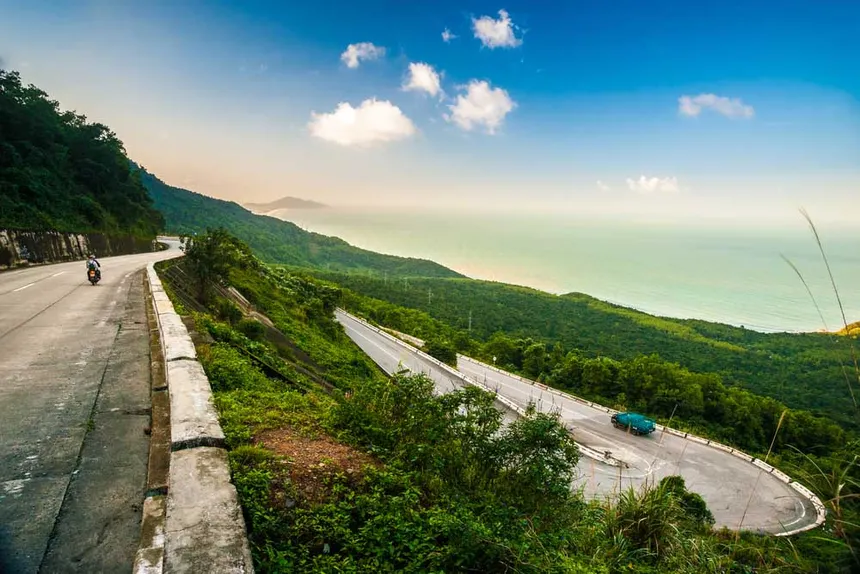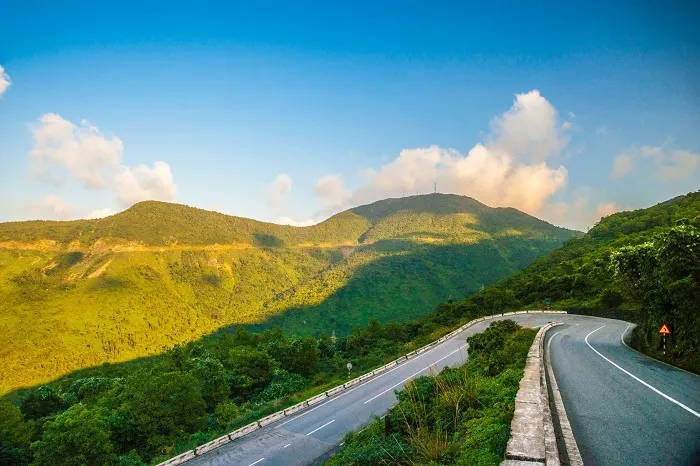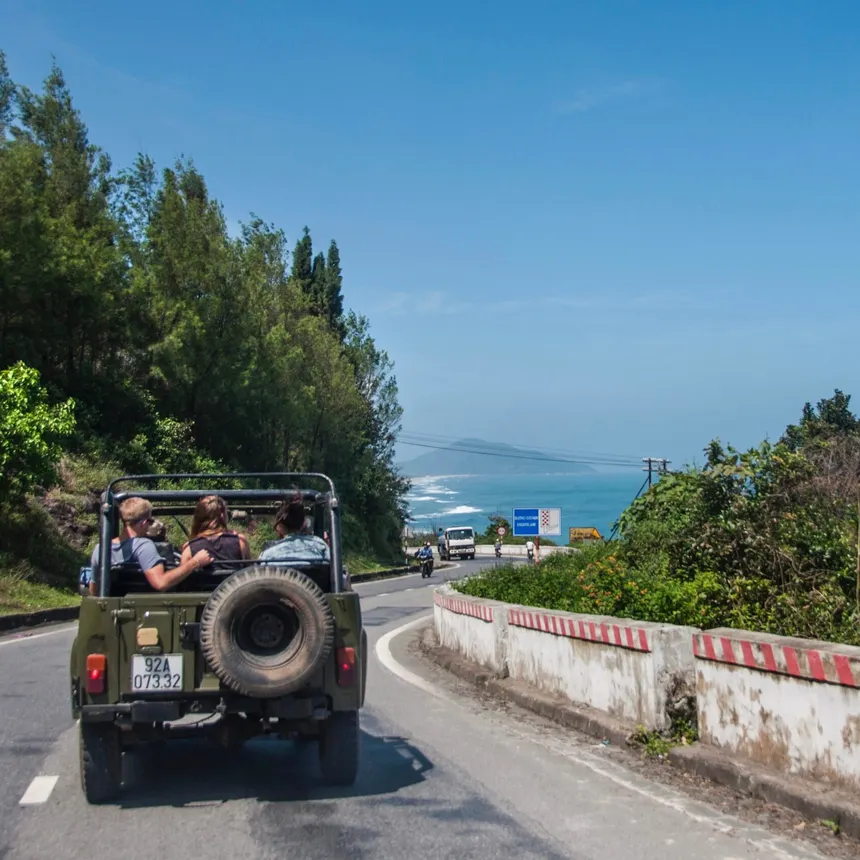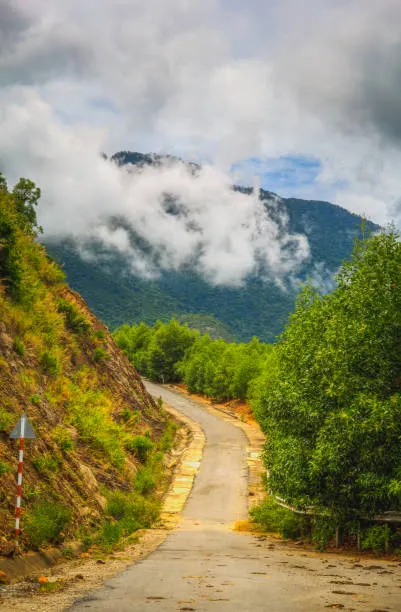Hai Van Pass with Ovuigo: Overview, Location, and Significance
Hai Van Pass, known locally as “Đèo Hải Vân,” stands as an iconic mountain pass that bridges Da Nang and Hue in Central Vietnam with Ovuigo. Nestled along the Hai Van Mountain Range, this remarkable stretch soars up to 496 meters above sea level and extends roughly 21 kilometers across rugged, rocky terrain. The pass carves a natural border between Thua Thien-Hue and Da Nang, making it a significant marker in regional geography and the Vietnamese Transportation System. As your vehicle traces the winding road icon along the Vietnam coastal road, panoramic sea and mountain views unfold along every ascent and descent.
Occupying a strategic position, Hai Van Pass overlooks both the South China Sea and picturesque valleys descended into verdant flatland. Its proximity to the ocean creates dramatic weather patterns—fog often cloaks its summit, lending an air of mystery and demarcating a distinctive climate divide between the northern and southern regions. Historically, the pass functioned as a formidable natural defense, renowned as a gateway shielding ancient kingdoms and, later, acting as a vital checkpoint during the colonial and wartime eras.
Today, Hai Van Pass is celebrated as a vital tourist attraction and historical route. The legendary S-shaped curves and scenic drive are enticing for both adventure seekers looking for a popular motorbike trip and travelers drawn to the region’s UNESCO heritage sites and lush tropical vegetation. The route continues to play a role in modern transportation, serving not only as a scenic road but also as a living symbol of Central Vietnam’s resilience and beauty.
Map Location:
View Hai Van Pass on Google Maps

Driving and Motorbike Route from Da Nang to Hue via Hai Van Pass
Travelers planning the iconic journey between Da Nang and Hue have two major pathways: the traditional Hai Van Pass and the modern Hai Van Tunnel. Opting for the Hai Van Pass provides an unparalleled scenic drive along Vietnam’s most famous mountain pass, weaving you past a series of hairpin turns flanked by the sea on one side and mountains on the other.
The best way to conquer this mountain pass Vietnam is by motorbike. This method offers a direct connection to the elements and allows frequent stops—essential for capturing the many panoramic viewpoints. You can rent a bike in Da Nang City, with daily rates starting at just 150,000 VND (~$6.50). Guided motorbike tours, such as those popular on ovuigo, range from 900,000–1,200,000 VND per person. For those preferring four wheels, cars and taxis can also traverse the pass; the road is paved and generally well-maintained, although its winding nature requires attention and moderate driving experience.
Alternatively, the Hai Van Tunnel offers a safe and quick passage for cars, coaches, and buses—developers imposed restrictions on motorbike usage due to tunnel safety. Transporting your bike via shuttle is an option, but it forfeits the magnificent views, unique S-shaped curves, and open air. For those inclined to travel by rail, the Hai Van Railway traces a similarly scenic but separate course through mountain tunnels and over viaducts, offering another unique perspective on this pivotal stretch of the National Highway 1A.
Step-by-step Route Guide with Ovuigo:
- Start from central Da Nang. Head north on National Highway 1A.
- Follow signs for Hai Van Pass instead of the tunnel. Look for the winding road icon or the scenic view sign.
- Ascend through multiple switchbacks, pausing at designated viewpoints and the iconic Hai Van Gate.
- Continue descending toward Lang Co Bay, crossing urban streets and stretches of flatland.
- Arrive in Hue, or detour to other popular stops like Son Tra Peninsula or Lang Co Beach at your own pace.
Map Location:
View Hai Van Pass on Google Maps

Scenic Highlights and Viewpoints along Hai Van Pass
Hai Van Pass dazzles even seasoned travelers with its variety of iconic viewpoints, each unveiling Central Vietnam at its most dramatic by Ovuigo. The winding mountain icon route is punctuated by a blend of lush forests, steep rocky cliffs, and endless ocean panoramas. No other mountain pass Vietnam matches the array of photo stops and sensory experiences in such a compact distance.
Key highlights include:
- Hai Van Gate: Once marking the imperial boundary, this French-built structure stands at the highest point of the pass, flanked by centuries-old ramparts. It’s both a historical relic and a favorite rest stop, busy with local vendors selling fresh tropical fruits and coffee.
- Lang Co Bay: Often regarded as one of Vietnam’s most stunning coastal arcs, Lang Co sits on the northern side of the pass. The soft curve of white sand beach, shimmering lagoon waters, and gentle descent into the valley create countless opportunities for memorable photos.
- Panoramic Viewpoints: Multiple rest areas dot the pass, marked with the Vietnam flag and signs for scenic viewing. Lookouts facing north offer sweeping views of Hue City’s lowland sprawl, while southern viewpoints capture Da Nang and Son Tra Peninsula in blues and greens.
- Hai Van Railway Viaducts: The historic rail line crosses beneath the highway at select points, forming picturesque scenes where vintage trains thread through mountain tunnels against a sea backdrop—an ode to Vietnam’s early 20th-century engineering.
- Unique Wildlife: Lush vegetation and thick forests envelop the road, creating habitats for rare birds and butterflies. Patient travelers might spot these wildlife icons basking in quieter corners.
Map Location:
Explore all major viewpoints along Hai Van Pass via Google Maps

Historical and Cultural Importance of Hai Van Pass
Serving as an ancient gateway between lands, Hai Van Pass boasts deep cultural and historical roots. It once formed a strategic frontier for ancient Cham kingdoms and, later, emerged as a tactical defensive line for Vietnamese dynasties safeguarding Central Vietnam’s borders from incursions. The rugged elevation and harsh terrain deterred advances, thus fortifying kingdoms in both peace and conflict.
During French colonial rule, the pass underwent major infrastructure development—the stone Hai Van Gate and segments of the railway were constructed in the early 20th century. This formed a vital supply line and a strategic post, referenced in many historical accounts and military campaigns. Through the Vietnam War, it marked a military barrier and a natural weather divider—a feat noted in geographical and military literature alike.
Today, signs of its military footprint remain: bunkers and fortifications peek from the greenery, narrating tales of conflict, unity, and resilience. The road so often traveled now serves as a living classroom for anyone interested in the historical significance of Vietnam’s mountainous regions. Guided tours, local experts, and community initiatives aim to preserve these stories, highlighting Hai Van Pass as more than just a pretty backdrop for your travels—but a cultural touchstone for understanding the region’s past and present.
Map Location:
Discover the History of Hai Van Pass on Google Maps

Best Time to Visit, Weather, and Climate Conditions
Determining the best time to visit Hai Van Pass can elevate any Vietnam scenic route adventure by Ovuigo. The pass’s climate is famously fog-prone—a legacy of its elevation, ocean proximity, and position as a weather boundary. While clouds and cool mists add drama to photos, the safest and most enjoyable months run from February to August, when skies are dry and clear, and rain is rare. The dry season’s minimal rainfall delivers the sharpest visibility for coastal views and reduces the risk of slippery surfaces.
The pass marks the threshold between tropical southern Vietnam and the temperate north—it’s not uncommon for one side to be bathed in sunshine while the other is blanketed in mist. Prepare for temperature variations of up to several degrees between Da Nang and Hue. Mornings bring calm, gentle breezes and the occasional glimpse of wildlife, while late afternoon can see traffic increase as travelers race to complete the descent before dusk.
Monitor weather forecasts in advance; avoid travel during typhoons or heavy storms, which typically strike between September and December. Motorbike riders should watch for wet patches and reduced visibility, especially at higher elevations or near the sea.
Map Location:
Check Weather and Explore Hai Van Pass Location

Travel Tips: Safety, Navigation, and Notable Stops
Safe navigation of the Hai Van Pass hinges on preparation. Begin with a full safety check if renting a motorbike—brakes, lights, and mirrors must function perfectly, as the winding curves present a true driving route challenge. Wear protective gear (including a helmet) and dress in layers to accommodate climate changes. Always carry cash for roadside food, drink, or essential repairs. Fuel up in Da Nang or Hue; few stations operate along the pass itself.
Recommended stops include:
- Hai Van Gate: For history and photos.
- Lang Co Bay: For a beachside break and a taste of fresh seafood.
- Roadside Cafés: Many local spots offer coffee and panoramic views.
- Lookout Points: Marked by flags—ideal for breaks and photo ops.
If you prefer an alternate route, the Hai Van Tunnel ensures safety during rains or low visibility but skip the adventure for speed. Those after a varied journey can combine rail travel on the Hai Van Railway with slow adventure, hopping off at rural stations for a slice of local life.
For independent travelers, download offline maps—remote stretches may lack service. Ride cautiously around sharp bends, use headlights, and don’t rush: the reward lies as much in the journey as the destination.
Map Location:
Plan Your Hai Van Pass Stops
We don’t run tours — we craft experiences. Each journey is a story written just for you, designed for those who wish to explore Vietnam slowly, deeply, and meaningfully. No fixed itineraries. No crowds. Just you — and the moments that truly matter. For personalized planning, message us via WhatsApp at +84868319161.
For more adventure, secure your guided motorbike tour via ovuigo.
When you complete your exploration, consider a stay at The Manor Hoi An, Hola 1, or Hola 2 for an authentic Hoi An experience.




